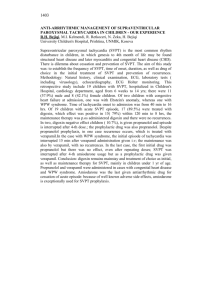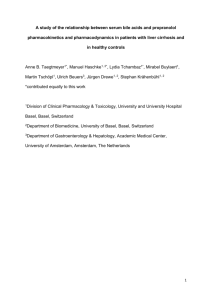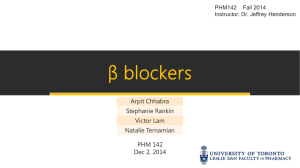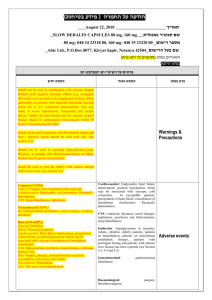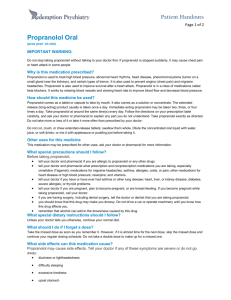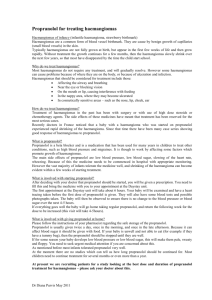determination of propranolol in the sanitary district of
advertisement
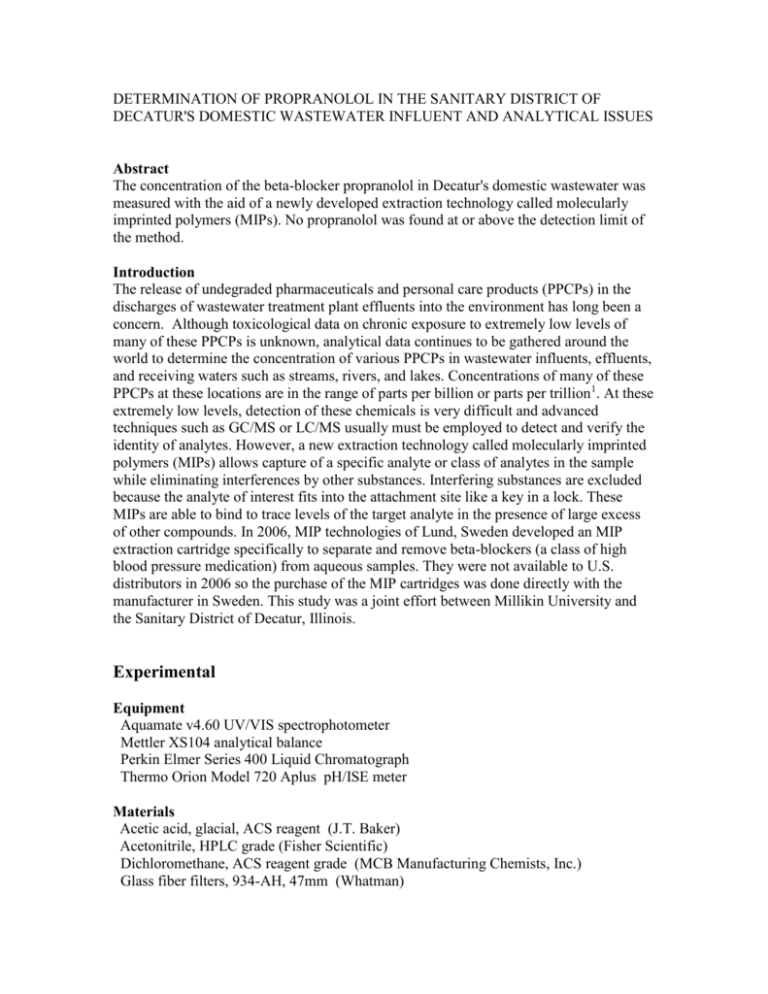
DETERMINATION OF PROPRANOLOL IN THE SANITARY DISTRICT OF DECATUR'S DOMESTIC WASTEWATER INFLUENT AND ANALYTICAL ISSUES Abstract The concentration of the beta-blocker propranolol in Decatur's domestic wastewater was measured with the aid of a newly developed extraction technology called molecularly imprinted polymers (MIPs). No propranolol was found at or above the detection limit of the method. Introduction The release of undegraded pharmaceuticals and personal care products (PPCPs) in the discharges of wastewater treatment plant effluents into the environment has long been a concern. Although toxicological data on chronic exposure to extremely low levels of many of these PPCPs is unknown, analytical data continues to be gathered around the world to determine the concentration of various PPCPs in wastewater influents, effluents, and receiving waters such as streams, rivers, and lakes. Concentrations of many of these PPCPs at these locations are in the range of parts per billion or parts per trillion1. At these extremely low levels, detection of these chemicals is very difficult and advanced techniques such as GC/MS or LC/MS usually must be employed to detect and verify the identity of analytes. However, a new extraction technology called molecularly imprinted polymers (MIPs) allows capture of a specific analyte or class of analytes in the sample while eliminating interferences by other substances. Interfering substances are excluded because the analyte of interest fits into the attachment site like a key in a lock. These MIPs are able to bind to trace levels of the target analyte in the presence of large excess of other compounds. In 2006, MIP technologies of Lund, Sweden developed an MIP extraction cartridge specifically to separate and remove beta-blockers (a class of high blood pressure medication) from aqueous samples. They were not available to U.S. distributors in 2006 so the purchase of the MIP cartridges was done directly with the manufacturer in Sweden. This study was a joint effort between Millikin University and the Sanitary District of Decatur, Illinois. Experimental Equipment Aquamate v4.60 UV/VIS spectrophotometer Mettler XS104 analytical balance Perkin Elmer Series 400 Liquid Chromatograph Thermo Orion Model 720 Aplus pH/ISE meter Materials Acetic acid, glacial, ACS reagent (J.T. Baker) Acetonitrile, HPLC grade (Fisher Scientific) Dichloromethane, ACS reagent grade (MCB Manufacturing Chemists, Inc.) Glass fiber filters, 934-AH, 47mm (Whatman) Methanol, Karl Fischer grade (Fisher Scientific) MIP extraction cartridges, 10mL, 25 mg sorbent (MIP Technologies) Nitrocellulose filters, 0.45 micron, 47 mm (Osmonics, Inc.) Nylon filters, 0.20 micron, 47 mm (Whatman) Nylon syringe filters, 0.22 micron, 17 mm (GE Water & Process Technologies) Phosphoric acid, 85%, certified ACS (Fisher Scientific) Polypropylene syringe filters, 0.45 micron, 13 mm (Whatman) Potassium phosphate monobasic, HPLC grade (Fisher Scientific) Propranolol hydrochloride, 99% (Sigma Aldrich) PVDF syringe filters, 0.22 micron, 13mm (Fisherbrand) Reconstituted cellulose syringe filters, 0.45 micron, 4mm (National Scientific) Procedure Initially the Sanitary District's research department staff during the spring semester of 2006 transported wastewater samples to Millikin University's chemistry laboratory and assisted a Millikin senior conducting the research with the initial filtering of the samples. During a followup visit later in the semester, it was noted that the student was reporting extraordinarily large concentrations of propranolol in the wastewater samples that SDD had provided for him. Because the levels were impossibly high, he was advised that the problem was probably carryover from highly concentrated propranolol standards injected previously. However, because of time limitations, the student was not able to resolve this problem before he graduated. After discussions with Dr. Acheson of Millikin University, the University agreed to allow the Sanitary District's research staff to use its facilities and instrumentation in order to continue the propranolol research. In June 2006, work began to try and resolve the problems encountered by the Millikin student. It was learned from his report that the Millikin student had been working in a concentration range of his standards about 10,000 times higher than was called for. It was also discovered that his chosen wavelength of 252 nm was a poor choice of wavelengths as propranonol absorbs very little light at 252 nm. Through a UV scan conducted at the SDD's research lab, it was determined that 216 nm was the peak absorbance wavelength for propranolol (see Chart 1 below). 2 Chart 1 : UV Scan of 10 mg/L Propranolol in Water 1.800 1.600 1.400 Absorbance 1.200 1.000 0.800 0.600 0.400 0.200 0.000 200 220 240 260 280 300 320 340 360 380 400 -0.200 Wavelength (nm) This finding also necessitated a change in mobile phase because the mobile phase the student had been using (a formate buffer /methanol mixture) absorbed too much light at 216 nm to be useful. A literature search2 determined that a pH 3 phosphate buffer with either methanol or acetonitrile as the organic solvent component would be the best choice. After some initial lab work at Millikin University's chemistry laboratory, it was determined that acetonitrile would work better than methanol for several reasons. One reason was that acetonitrile absorbs less light than methanol at 216 nm thereby resulting in better propranolol sensitivity. Another reason is that acetonitrile is less viscous than methanol resulting in lower operating pressures for the HPLC pump. Also a methanol/water gradient elution has a very unusual pressure spike3 when going from 100 % water to 100 % methanol. It was noted in early investigations at Millikin that a pressure maximum (1.5 times that of 100% water) occurred at 60% methanol / 40% water instead of the pressure maximum occurring at 100 % water which would be expected based on the viscosities of water (0.89cP) and methanol (0.55cP). After many test runs it was determined that 68% 0.01M PO4 buffer / 32% acetonitrile would be the best mobile phase. This was chosen because it allowed the elution of the propranolol peak in a reasonable amount of time (7 minutes compared to 37 minutes for study done by the Millikin student). Isocratic elution was chosen over gradient elution again because of the time factor. In gradient elution, time would be wasted waiting for the system to equilibrate back to initial operating conditions between each run. Time was of the essence since the HPLC analysis was conducted at Millikin University many blocks away from the District's laboratory. 3 A recurring problem was that of carryover. It was found that when injecting a blank (deionized water) a propranolol peak would still appear on the chromatogram. Injecting several blanks in a row resulted in a diminished propranolol peak but it could not be completely eliminated. For initial work therefore a blank was injected between each sample or standard so that the background level of residual propranolol could be factored out of the calculations. Later on in the study a method of cleaning out the injection port was realized that resulted in a complete removal of the ghost peak. The minimum level of detection using the techniques and equipment described in this report was estimated to be around 200 parts per trillion (200 nanograms / Liter) in the original sample, or 0.01 mg/L in the reconstituted sample assuming 50 times concentration factor. Since the level of propranolol in Decatur's wastewater was unknown, it was decided to focus first on domestic wastewater which should have a higher concentration of propranolol in it than industrial wastewater or SDD's influent (a mixture of industrial and domestic wastewater). The domestic wastewater chosen for this study was from the Lost Bridge Pumping Station that receives wastewater from a residential area in the southeast part of Decatur, IL and pumps it to the District's main plant. A 1000 mg/L propranolol stock standard solution was prepared by dissolving 230.4 mg of 99% propranolol hydrochloride (f.w. = 295.81 grams) in deionized water and diluting in a 200 mL volumetric flask to the mark. Successive dilutions were made at 100, 10, 1 0.100, and 0.050 mg/L concentration levels. The MIP extraction cartridges received from Sweden were seated securely to a 1 liter vacuum flask by means of a small plastic funnel which had its stem and lower half of its cone cut off. The cone of the funnel was partially cut off so that the cartridge would snugly slide down inside the aperture of the stemless funnel with a rubber o-ring placed around the cartridge up against the cartridge's lip to provide a vacuum seal with the funnel wall. To provide a vacuum seal between the funnel top and the top of the filtering flask, a flat rubber washer was employed. Steps of Extraction Procedure. Cartridge Conditioning: 1 mL of methanol added to cartridge followed by 1 mL of deionized water. Sample Application: 100 mL of 0.45 micron filtered sample applied to cartridge at a rate of 1 mL /minute. Elution of Interferences: For the following cartridge rinses, flow rate through cartridge was maintained at about 0.5 mL/minute. Two 1 mL portions of deionized water (followed by 2 minutes vacuum) One 1 mL portion of acetonitrile One 1 mL portion of 60% acetonitrile / 40% water (followed by 10 minutes vacuum) 4 One 1 mL portion of dichloromethane (followed by 2 minutes vacuum) After these rinses were completed, a 10 mL Erlenmeyer flask was suspended by a string inside the one-liter vacuum flask in such a way that the bottom 1/3rd of the MIP cartridge extended inside the Erlenmeyer flask. In order to elute the beta-blockers captured on the cartridge column, a one mL aliquot of a 90 % methanol /10% glacial acetic acid mixture was applied to the column with no vacuum to allow for maximum contact time between solvent and sorbent. After this initial aliquot passed thru the column and collected inside the 10 mL flask, gentle vacuum was applied for about 30 seconds. Next, a second 1 mL aliquot was applied in the same manner as the first. After the elution of analytes was completed, the 10 mL Erlenmeyer was removed from inside the vacuum flask and placed in a 32 C water bath to gently drive off the methanol. Once the methanol was driven off, the temperature was raised gradually to 42 C to evaporate the remaining acetic acid. After evaporation of the solvent was completed, the Erlenmeyer flask containing the dried extract was covered with aluminum foil and stored at room temperature until analyzed by HPLC at Millikin University. A vacuum oven would have been a quicker way to dry the extracts but neither the Sanitary District nor Millikin University had one. On one occasion the extracts were dried in a vacuum oven located at an ADM research lab as described later in the report. HPLC analysis. Preparations for HPLC analysis included preparing the mobile phase at the SDD research laboratory either the day of analysis or the day before. The mobile phase was 68 % 0.01 M PO4 buffer / 32% acetonitrile. The 0.01 M PO4 buffer was prepared by adding 1.2017 grams KH2PO4 and 11.7 mL of 0.1 M phosphoric acid to a one-liter volumetric flask containing about 200 mL of deionized water and then diluting to volume with deionized water. In order to prepare 750 mL of the mobile phase, 510 mL of 0.01 M PO4 buffer along with 240 mL of acetonitrile were mixed together in a one liter flask and then filtered thru a 0.22 micron nylon membrane filter. The filtered mobile phase was then placed in a 1L glass storage bottle and transported to Millikin University laboratory. HPLC startup procedure included degassing the mobile phase by bubbling helium thru it for 5 minutes. Next the solvent pump was primed. Then the analytical column that other researchers were using was detached so that the injection port could be thoroughly flushed out by starting the solvent pump and switching the injection valve from load to inject several times. Deionized water was continuously pushed thru the manual injection port while the injection port was switched back and forth from load to inject. This procedure, which was not adopted until late in the study, removed residue from previously injected samples of other researchers. Once the injection port had been thoroughly cleaned out, a Phenomenex Prodigy 5 ODS-3, 250 x 4.6 mm analytical column was installed. Mobile phase flow rate was set at 1.0 mL/ minute, and the system was allowed to equilibrate for about 20 minutes until there was a stable baseline absorbance. The system pressure usually remained in the range of 1880 to 2060 psi. Samples and standards were normally injected via a disposable syringe tipped with a 0.22 5 micron PVDF filter. In between each sample or standard injection, a thorough cleaning of the injection port was done to eliminate any residual propranolol. The cleaning involved switching back and forth the injection valve from load to inject while continously pushing deionized water into the injection port. This procedure was not implemented until fairly late in the study. Before this procedure was adopted, there was always a residual ghost peak no matter how many times blank water was injected between samples. During the cleaning procedure described above, the Labview data collection system remained off. After the cleaning was completed, about 7 minutes was allowed for the system to equilibrate. Then a blank (deionized water) was injected with the Labview integration started to verify that there was no sample carryover. At the end of the day's analysis, the column was flushed out with a gradient elution starting with 68 % deionized water / 32 % acetonitrile which was held for 10 minutes, and then a linear climb to 100 % acetonitrile over a 12 minute period followed by about 10 minutes of continued flushing with 100 % acetonitrile until pressure and absorbance stabilized. Results and Discussion Many problems were encountered during this study. One of main difficulties was the trace level nature of the work. This caused a major problem with regards to sample filtering. Normally a membrane filter removes particulate matter and allows the passage of the dissolved constituents. However, there may be an affinity between the membrane and some dissolved substances which causes a very small amount of dissolved analyte to become embedded on the membrane. When the analyst is working at higher concentrations this capture of a miniscule amount of analyte by the membrane is of no concern because it represents far less than one percent of the analyte passing thru the membrane. However during the latter portion of this study it was discovered that when 1 mL of a 0.05 mg/L propranolol standard was injected into the HPLC sample port thru a PVDF membrane filter over 90 % of the analyte was captured by the filter. This problem was not noticed earlier because 5 mL instead of 1 mL of standard was flushed thru the syringe filter prior to injection in the early phases of the study. The amount of propranolol that was captured in the above example is only 45 trillionths of a gram assuming a 90% capture rate. The membrane adsorption problem could probably have been eliminated if unlimited sample was available. That is, after flushing thru several milliliters of sample, the membrane would have become saturated with propranolol, and the HPLC sample loop could then be filled with sample undiminished in propranolol concentration. Unfortunately in this study unlimited sample extract was not available as only 2 mL was the reconstitution volume from the original 100 mL sample volume. Several different types of membrane filters were tested out to try and find one that would have low sample binding. PVDF (polyvinylidene fluoride) filters were used for most of the study. Other filters that were tested out included nylon, reconstituted cellusose, and polypropylene. All of these had significant sample loss when using 1 mL of a 0.05 mg/L propranonol standard. 6 The extent of removal of propranolol by the injection filter can be seen clearly by comparing the sizes of the propranolol peaks in Charts 2 and 3. 7 It is readily seen from Chart 2 that the propranolol absorbance is much less than 0.001 for the filtered sample whereas the unfiltered sample (Chart 3) had an absorbance greater than 0.004. The type of filter used in Chart 2 was a PVDF syringe filter of 13 mm diameter and 0.22 micron pore size. Because of the poor results seen when using injection filters, it was decided to go with using no filter at all for the remainder of the study. This was somewhat risky because of the danger of plugging the very small diameter tubing (0.01 mm) involved in HPLC equipment. However, no adverse effects were encountered. On two separate occasions in the spring of 2007, analysis was done on Lost Bridge Pumping Station wastewater using no filter for HPLC injection. On both occasions, a 0.001 mg/L propranolol standard was also extracted so that a % recovery could be determined. In turn, the % recovery of the extracted 0.001 mg/L propranolol standard was judged against a 0.05 mg/L non-extracted standard. After extracting 100 mL of the 0.001 mg/L standard and reconstituting it to 2 mL, it should also have a theoretical concentration of 0.05 mg/L. The % recovery was 37.8% for the first extracted standard analysis done on March 20, 2007 and 28.0% for the standard analyzed on June 8, 2007. No propranolol was detected in either of the two Lost Bridge pumping station samples with sample dates of March 14, 2007 and June 1, 2007. In the absence of an injection filter, possible areas where analyte losses might have occurred include: 1) losses from lack of adsorption of the propranolol onto the cartridge column, 2) losses during interference rinses, 3) losses from only partial elution of the propranolol from the MIP column during elution with 90% methanol / 10% acetic acid or 4) losses during the drying and reconstitution process. There have been indications of loss in the areas of drying and reconstitution during this study as the experiment below illustrates. An experiment to evaluate different drying methods was conducted in October 2006. Four mL of a 0.025 mg/L propranolol standard dissolved in 90% methanol / 10 % acetic acid was placed in each of three 10 mL Erlenmeyer flasks. No extractions were involved in this experiment so that only activities occurring after extraction (drying, reconstitution, and syringe injection thru filter) could be evaluated. Two of the flasks were taken to the ADM Lakeview Research Center and evaporated quickly in a vacuum oven set at 30C. The other standard was evaporated in a water bath over a period of a couple of days at the SDD research laboratory. All three standards were reconstituted with 2 mL of deionized water thereby making a theoretical concentration of 0.05 mg/L. Percent recoveries for the three standards were measured against a 0.05 mg/L propranolol standard which did not go through the drying and reconstitution process. When analyzing the three dried and reconstituted standards by HPLC at Millikin, first a 1 mL aliquot was injected and integration started. After the run was over, a second 1 mL aliquot of the same standard was injected after it passed thru the very same 0.22 micron, 13 mm PVDF filter. It was noted for all three standards that the second 1 mL aliquot had an absorbance from 8 to 12 times higher than the first 1 mL aliquot. The % recoveries for the second 1 mL aliquots were 29.2 % and 37.8% for the vacuum oven dried standards and 42.0% for the standard dried in the water bath. In retrospect, it might have been better to have injected these standards without passing them through any filter because the filter may have lowered the 8 absorbances of the second 1 mL aliquot injections also. But at the time this experiment was conducted in October of 2006, other options were going to be explored first (using other filter types) before taking the chance of plugging up the HPLC narrow bore plumbing. The use of more advanced equipment and techniques is needed to accurately determine the concentration of propranolol in Decatur's wastewater. A study of propranolol in California wastewater and surface waters by D. Sedlak4 had a very low detection limit of between 0.1 and 1.0 nanograms/L depending on sample matrix and instrument response. This limit was achieved using gas chromatography / tandem mass spectrometry (GC/MS/MS). The solid phase extraction procedure that Sedlak employed was simpler and had a concentration factor of up to 8000 which is much better than the 50 times achieved in this report. It was noted in his study that the use of freshly silanized glassware resulted in better recoveries. If further work is to be done with propranolol at the Sanitary District, it is recommended that gas chromatography be used with derivitization. After a possible propranolol peak is identified by retention time and sample spiking, a mass spectrometer could be used in conjunction with gas chromatography to determine the identity of the peak with great certainty. Using GC would also eliminate the need of an analyte robbing filter during sample injection. Future research work on beta-blockers might include metoprolol and atenolol which have been shown to exist in higher concentrations in wastewater as the following literature data illustrates. The average concentration of metoprolol was 1263 nanograms/L when measured5 in the effluent of the six largest wastewater treatment plants (WWTPs) of Dallas, Texas on September 14-15, 2005. At the same time, the propranolol average concentration was only 82 nanograms/L at these same six WWTPs. In another study, Vandeford1 found that atenolol existed at 3060 ng/L in the wastewater influent and 879 ng/L in the wastewater effluent of the City of Las Vegas Water Pollution Control Facility. Atenolol may be the best of the three to study because it is not metabolized6 by the human body at all whereas both propranolol and metoprolol undergo extensive human metabolism. Conducting further research on propranolol or other trace organic compounds should be done at the SDD lab if possible. Scheduling around student researchers and the need to transport chemicals and supplies back and forth to the college campus make it difficult to conduct effective research at a remote work site. Acknowledgements The authors thank Dr. Ed Acheson of Millikin University for his invaluable advice and assistance during the study. We also wish to thank Chuck Newgard of Archer Daniels Midland Company for helping us to access and use their research laboratory's vacuum oven. 9 References (1) Vanderford, B.J.; Snyder, S. S. Analysis of Pharmaceuticals in Water by Isotope Dilution Liquid Chromatography/Tandem Mass Spectrometry. Environmental Science & Technology. 2006, 40, 7312-7320. (2) Basci, N.E.;Terizer,A.; Bozkurt,A.; Isimer, A. Optimization of mobile phase in the separation of -blockers by HPLC. Journal of Pharmaceutical and Biomedical Analysis. 1998, 18, 745-750. (3) LC Resources, Inc. Getting Started in HPLC, An Introductory On-Line Course. http://www.lcresources.com. (4) Fono, L.J.; Sedlak, D.L. Use of the Chiral Pharmaceutical Propranolol to Identify Sewage Discharges into Surface Waters. Environmental Science & Technology. 2005, 39, 9244-9252. (5) Fono, L.J.; Kolodziej, E.P.; Sedlak, D.L. Attenuation of Wastewater-Derived Contaminants in an Effluent-Dominated River. Environmental Science & Technology. 2006, 40, 7257-7262. (6) Sedlak, D.;Pinkston, K. Factors Affecting the Concentration of Pharmaceuticals Released to the Aquatic Environment. Journal of Contemporary Water Research and Education. 2001, v120, p56. 10
